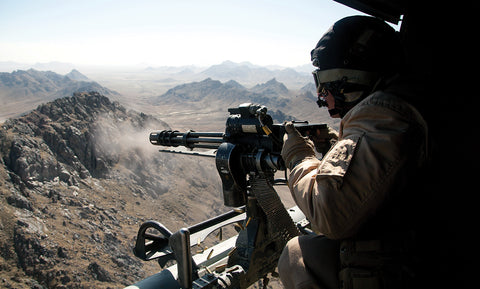
These Aircraft Have Saved Men on the Ground
From 1794, when French balloonists dropped messages from the basket of l’Entreprenant to report on Austrian troop movements to the first use of Morse code conveyed by electrical cables by Union aeronauts in 1861, armies developed means of coordinating intelligence gathered from the air to their forces on the ground quickly enough for it to be useful. The airplane entered the picture in 1911 during the Italian invasion of Ottoman-held Libya, when the first scouting flight was followed within days by the first hand-dropped explosives. In 1912 British experiments with wireless signaling enabled the airplane to provide troops and artillerists what they needed to know in real time, and throughout World War I improvements in the aircraft led to more means of harnessing their potential to provide well-coordinated close air support. By 1918 that included airdrops of ammunition and supplies, as well as specialized ground attack planes, taking the fight down on the enemy.
Introduced to military use during World War II and made practical during the Korean War, the helicopter became an indispensable supplement to the airplane, with the added advantage of being able to land and depart from terrain where an airplane could not—a critical asset to which many a medevaced soldier owed his life.
A Farman III biplane performs scouting duties during
a French artillery exercise near Châlons-sur-Marne (present-day Châlons-sur-
Champagne) in 1910. A year later Italy would use warplanes in earnest in
Libya. (Branger/Roger VIollet, FPG, Print COllector, Corbis (Getty Images))
Bulgarian airmen in a Blériot XI-2
set out on a bombing mission against Ottoman defenses in Adrianople (present-
day Edirne, Turkey) in 1913 during the First Balkan War. (Branger/Roger
VIollet, FPG, Print COllector, Corbis (Getty Images))
An S.E.5a (left) and a Sopwith Camel strafe German trenches as
the prelude to a British ad-vance in late 1917. Fighter pilots, who were fair
game for every enemy holding a gun, considered it a “dirty job,” but it
increasingly became a regular part of their duties. (Branger/Roger VIollet,
FPG, Print COllector, Corbis (Getty Images))
Junkers Ju 87D Stukas peel off to attack a Soviet
road column in a classic use of the dive bomber as “flying artillery”—provided
there is no aerial opposition. (Bundesarchiv)
Carrier-based Grumman
TBF-1 Avengers soften up Japa-nese fortifications for advancing Marines on
Namur, Kwajalein Atoll, on Feb. 1, 1944. (National Archives)
A Stinson L-5 Sentinel does artillery spotting for Marines on
Okinawa on June 2, 1945. (U.S. Marine Corps (Associated Press);)
The observer in a U.S.
Navy aircraft trains in aerial photography at Naval Air Station Norfolk, Va.,
in 1940. (Branger/Roger VIollet, FPG, Print COllector, Corbis (Getty Images))
An Eastern
Aircraft TBM-1 spearheads a Marine assault on a hidden Japanese strongpoint on
Okinawa on April 1, 1945. (R.A. Bailey (U.S. Marine Corps))
Douglas AD-4 Skyraiders of attack squadron VA-75 from
the carrier Bon Homme Richard (CV-31) hit communist positions in Korea in
1952. (U.S. Navy)
Cooperating with radio-equipped forward combat controllers, a
Vought F4U-4 Corsair bombs an enemy bunker in Korea on Aug. 19, 1952. (U.S.
Marine Corps )
More typically used as a night fighter, a U.S. Marine
Grumman F7F Tigercat provides close air support for colleagues on the ground
in Korea. (U.S. Navy)
Bell UH-1 Iroquois “slicks” transport elements of the
173rd Airborne Brigade to their first operation 8 miles from Bien Hoa,
Vietnam, while other Hueys, armed with machine guns and rockets, plaster a
suspected Viet Cong position on Sept. 18, 1965. (Bettmann (Getty Images))
Responding to reports of Viet Cong mortar attacks on two
landing zones in 1966, a Vought F-8E Crusader of U.S. Marine fighter (all-
weather) squadron VMF (AW)-312 unloads on a target after its element leader
dropped its bombs. (U.S. Marine Corps)
On May 19,
1969, amid the grueling 10-day struggle for Ap Bia Mountain, aka “Hamburger
Hill,” a wounded trooper of the 101st Airborne Division is medevaced by Huey
helicopter to the nearest facility. (Associated Press)
Sergeant Samuel Galan of U.S. Marine light helicopter
attack squadron HMLA-169 breaks up a Taliban ambush in Helmand province,
Afghanistan, using a minigun mounted in a Bell UH-1Y Venom helicopter gunship
on Feb. 3, 2013. (Corporal Alejandro Pena (U.S. Marine Corps))
